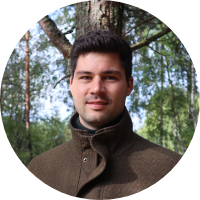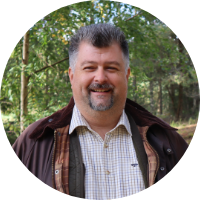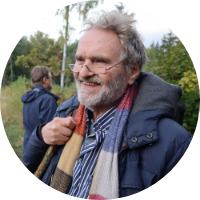
Overall solutions for investors
HD Forest is part of Hedeselskabet and has been managing forests in the Baltics since 1998. For a quarter of a century, the company has managed forests for several Danish and international investors from three offices in Estonia, Latvia and Lithuania.

Text and photos: Joakim Bisgaard Jensen
"We offer an overall solution where we help invest in the forest and subsequent manage it for the investors in order to maintain and develop the value of the forests," Morten Thorøe explains.
According to the manager, the Baltics still has a huge forest resource which is managed very extensively, or not at all. This is where HD Forest makes a difference, Morten Thorøe says, as the company offers structure, modern technology and market insight:
"In all modesty, I can say that we've introduced various fixed routines and an approach to forest management which is not offered by many others in the Baltics."
HD Forest has 25 employees and today manages some 100,000 ha forest, divided between the three Baltic countries. For the last couple of days, the interested investors have seen only a very small section of theses forests which Morten Thorøe and his Baltic colleagues have presented on the trip to Estonia and Latvia.


I think we've had a really thorough insight into how they're managing the forests here. Forest management here is somewhat more extensive than in Denmark. They are planting less and leaving the forests to regenerate on their own. This is probably the biggest difference I noticed.
Gert Ladegaard Jensen, forest owner near Jordrup




A natural forest image
From the birch forest near Tartu in Estonia, the group is now moving to a younger growth of Norway spruce. The Estonian Country Manager of HD Forest, Toomas Kams, leads the way. He stops at a large Scotch pine. The reddish trunk stretches for the sky, ending in the characteristic bluish green treetop. It is surrounded by several other Scotch pines from the previous generation and all of them reach far above the roof of the pine tops.
”Can you take out this pine, when you thin next time?” the Danish forest owner Johan Tesdorpf asks, one of the seven participants on the trip.
"No, probably not. I will damage too much," Toomas Kams replies. He suggests that the pine could perhaps be felled with the Norwegian spruce once they're mature for felling.
The image of a mixed forest is very typical for the Baltics where most growths have more than one tree species. This is due to the natural approach to forestry where Estonia and the rest of the northern Baltics in particular provide excellent conditions for self-seeding of trees in the forest floor - also known as natural regeneration.
"Cultivation conditions are different from what are known in Denmark. For example, climatic differences result in different weed pressures which means that regeneration happens easier," Morten Thorøe explains, making it clear that it may become necessary to plant if nature cannot handle the task on its own. "However, if after 10 years, birch, pine and spruce have been regenerated, you really shouldn't rush into planting other tree species at high costs," he emphasised.
Planting trees in the Baltics, you're not spoiled for choice as importing alien species is not permitted such as grand fir, Sitka spruce and Douglas fir which are popular with many Danish foresters. However, Baltic foresters must base cultivation on domestic species which are mainly Norwegian spruce, Scotch pine, birch, aspen and alder wood.
"This is a somewhat more patient type of forestry, as you might say," Morten Thorøe replies regarding the differences between Baltic and Danish forestry.
"Seen from the outside, our forestry here may look a little more extensive but looking at the results in both cubic metres and money terms, it very much holds it own against the forestry operated to the West, both in Denmark and in other European countries."



Slats for Swedish beds
The trip has now left the forest for the next stop on the route. A sweetish scent spreads from the huge, blue, container-like machine. The noise is so deafening that we've been given earplugs at the entrance to the large hall where the pleasant heat renders our jackets superfluous. At the end of the blue machine, three women remove the paper-thin, yellowish-white sheets and place them in stacks on separate pallets. As three towers of Bruin's pancakes.
Outside on the site, huge stacks of fine, round birch trunks which the Estonian lamination works Tarmeku changes into plywood products, mainly bed slats for IKEA. The blue peeling machine in the hall steams the wood and peels off thin layers of the white trunks. The laminates are then glued crosswise in seven layers. Finally, the plywood sheets are cut into the curved bed slats.
The lamination works is the trip's second stop in the Baltic timber industry. The day before, HD Forest had presented the Swedish sawmill Stora Enso in Latvia which cuts approximately 800 cubic metres of raw wood a day of which 90 per cent of the wood comes from Latvia. Today, much of the Baltic timber industry consists of Swedish, Finnish and German companies that have been able to see the value of the huge forest resources in the region.
They have helped develop the industry so that today, the Baltic forest sector has stable sales to state-of-the-art plants working according to sustainable directions: bark is used to heat the plant, sawdust is reused for wood pellets and the remaining wood chips may be used in the cellulose industry. Nothing goes to waste.
The three women at the blue, steaming machine show how normal it is in the Baltics to be employed in the forest and wood industries. For example, the Latvian forest sector employs more than six times more people than the Danish sector, considering the population.


Without a background in forestry, this trip really helps you understand how forestry works. We see the trees from planting to logging and up to the finished IKEA product. This was really cool to see. My idea is to have an afforestation project here in the Baltics but I have also become aware of a more traditional forest investment having seen the entire value chain.
Alessandro Colombo, Italian private investor residing in Copenhagen




A strong Forestry Act
We've driven on a gravel highway in Latvia with forests on both sides as far as the eye can see. Surrounded by sorrel and leaves of grass is a greyish and light spotted branch from which tree jet-black pillows extrude: the wood must be weaved through by hyphae. The branch is from one of the huge, wrinkled aspen in among the equally tall Norway spruce in the 95-year-old growth. Forester Martins Pupols shows the impressive growth to the Seven European forest guests and to his four colleagues from HD Forest where he has been working since 2005. Today, he manages around 10,000 ha of forests and farms in Latvia for his eight international clients.
"The first thing to consider when managing Latvian forests is our local legislation," points out Martins Pupols when asked about certification rules.
Martins Pupols says that in Latvia, they are mainly certified according to PEFC forest standards ensuring sustainable forestry. In everyday life, certification rules only takes up little room compared with the national legislation which according to him is very strict.
"We are not as free as for example in Denmark where forest owners are free to carry out most activities in the forest without permission from the authorities. In Latvia, you must ask for a permission before doing anything in the forest," he explains.


I really appreciate having discussions with regional foresters to make out the details of an investment. The structure with many small properties would usually increase the administrative burden considerably, however, this does not appear to be the case having HD Forest at the helm. This I take with me as a very positive aspect.
Lorenz Wisenberg, adviser to private forest investors, Bavaria

For example, a permit is required in Latvia before felling large trees, no matter if you are felling many or only a few. This is partly to register the origin of the timber which is why thinning permissions are easy and quick to obtain.
"Actually, compliance with the rules is not difficult; you learn to navigate through them. It just gives me a little more work," Martins Pupols says with a wry smile, stressing that he is not sorry about his country's legislation as it helps ensure proper forest management.
Legislation varies between the three Baltic countries. Lithuania has the strictest forestry act while the Estonian legislation is more liberal, according to the Latvian forester who explains that his own homeland is probably somewhere between the two extremes. Common to all three countries is an obligatory requirement for a working plan to ensure sustainable use of the forest's resources. By way of comparison, the Danish Forestry Act has no requirements for a working plan.
HD Forest focuses on sustainability. Using forest measurements and state-of-the-art technology, the employees monitor that they do no fell more timber than grows out to ensure the regeneration of timber in the forests. Morten Thorøe also emphasises that the operation takes biodiversity into account:
”We are taking both local biology and nature into account and all of our managed forests in the three Baltic countries are certified according to FSC or PEFC standards for sustainable forests. So we are doing much to ensure sustainable forestry in our Baltic areas," the Danish HD Forest manager concludes.


I have a general interest in forests, and the Baltic market offers more attractive land prices than what we see in Denmark. That's why it could be an interesting place to expand my forest portfolio. It's nice to go in a group of persons from different countries and with different backgrounds. The dynamics are excellent when you hear questions from the other participants, and travelling in a group is just great fun.
Johan Tesdorpf, forest owner near Odder, Denmark

Mutual inspiration
The white bus approaches the airport in Riga. Two days of excursions are nearing the end for the seven international forest guests. We glide past large passages of red-trunked Scotch pine; right here the forest is not as mixed as it is elsewhere. The HD Forest manager takes stocks after a couple of days in Latvia and Estonia which, according to him, has been a success. Personally, he enjoyed the trip with an international gathering:
"I find it inspiring to meet people with another background than ours. Other things being equal, Denmark is a small, homogeneous society where, in particular, the forest sector is not that large. So it's wildly exciting to meet this group of investors that have joined our trip as they come from four different European countries and have very different backgrounds in terms of their objectives for the trip."
He believes that HD Forest will continue its positive development given the huge potential in the Baltic forests - and because society is moving into an era where the demand for bio-based products will grow. However, the manager also sees other missions for the Danish-based company in the Baltics:
"We can also help in relation to the future development of the Baltic countries to build an even stronger forest sector. And here in the Baltics, forestry is just hugely important. It's a much more critical factor than what we are used to in Denmark."





